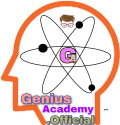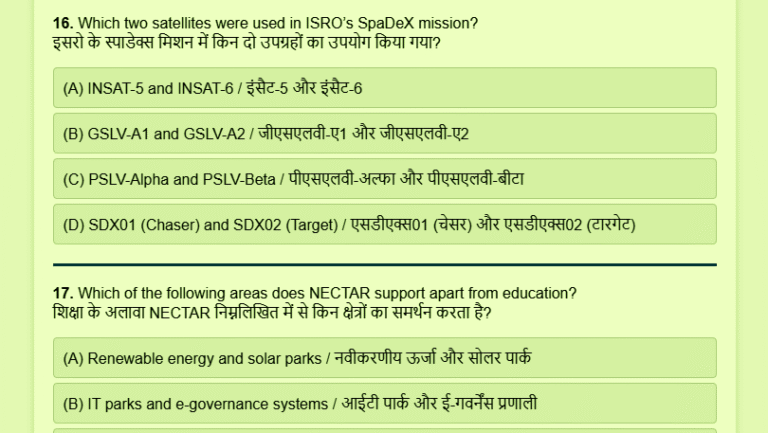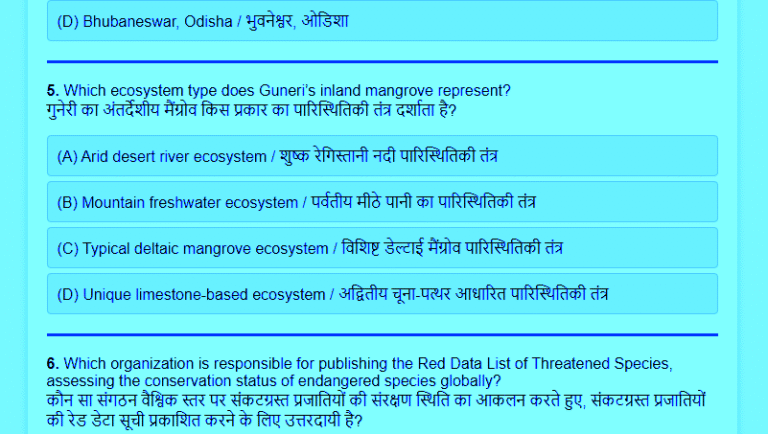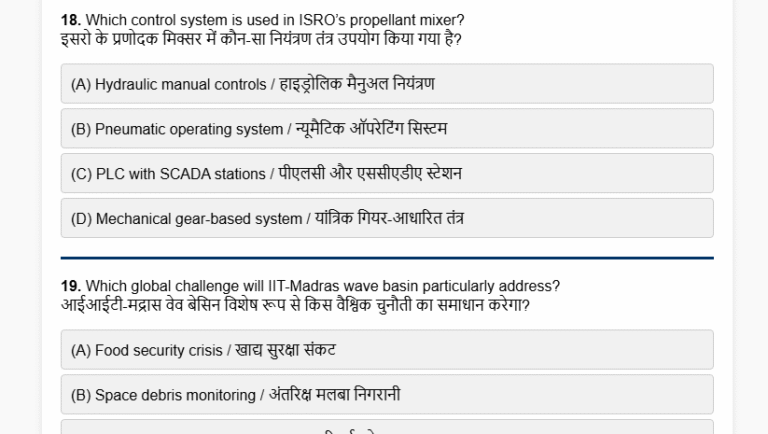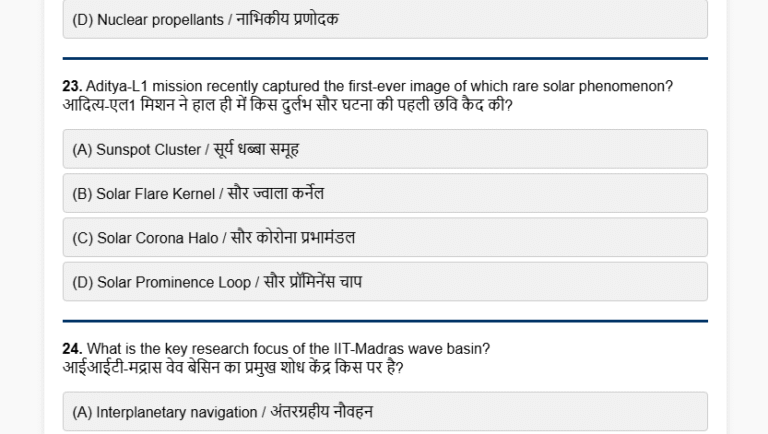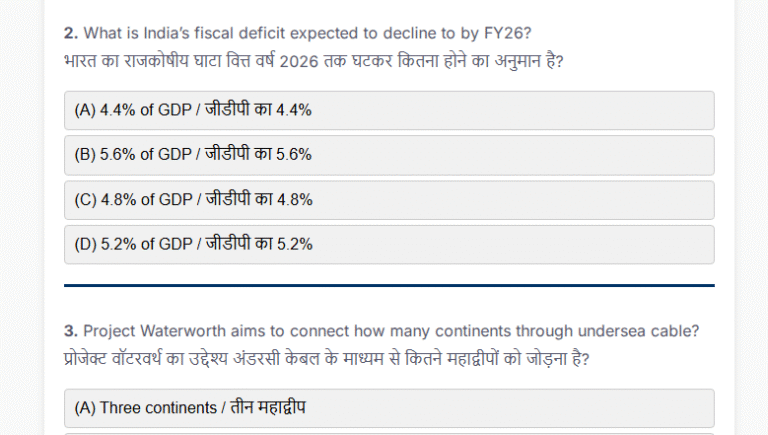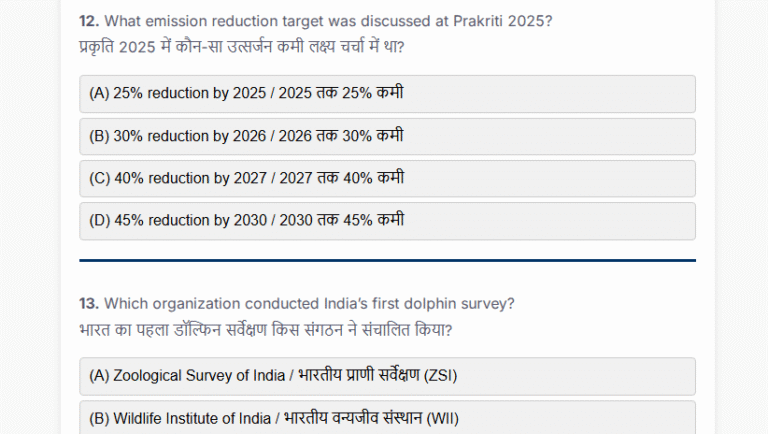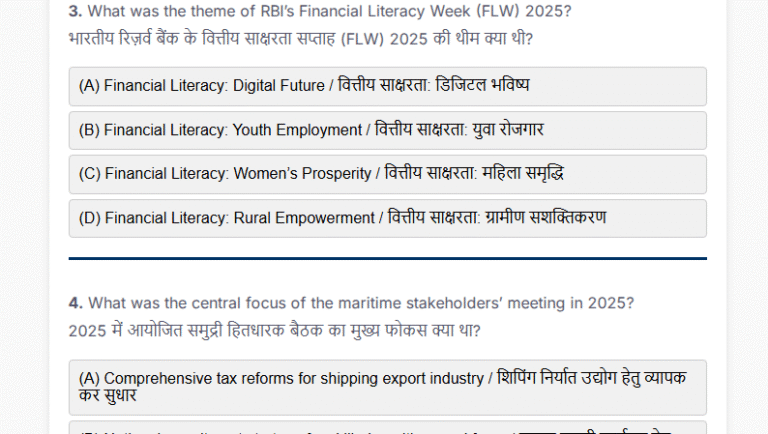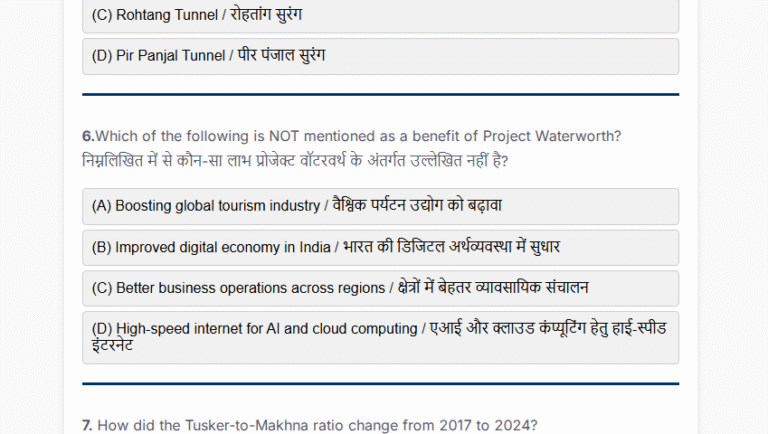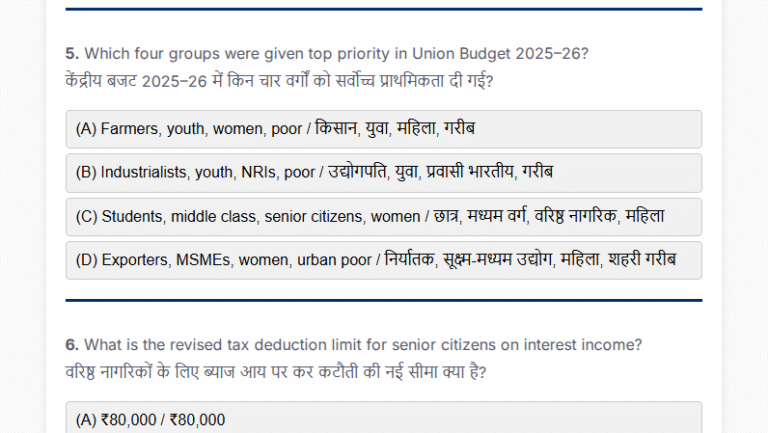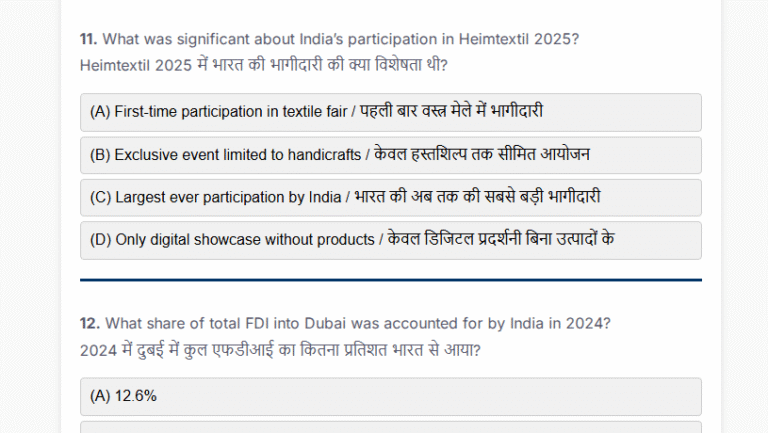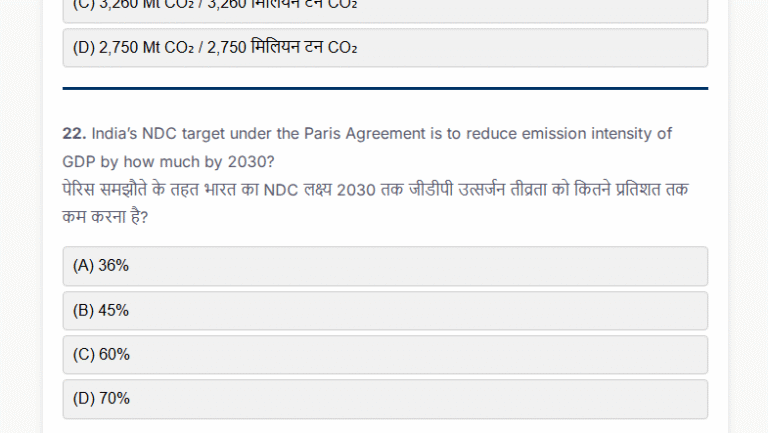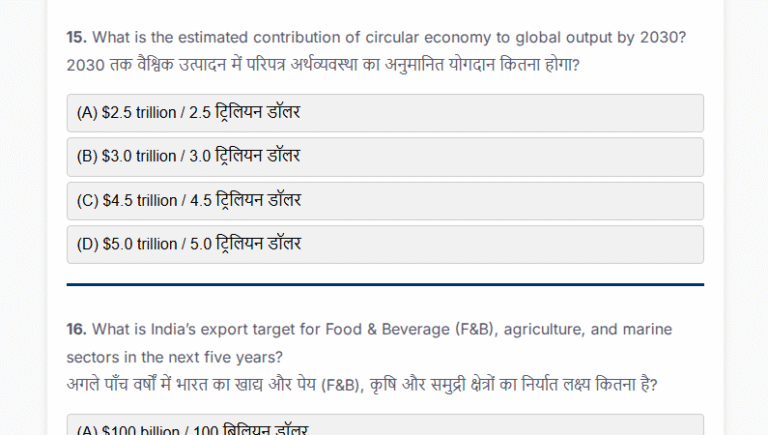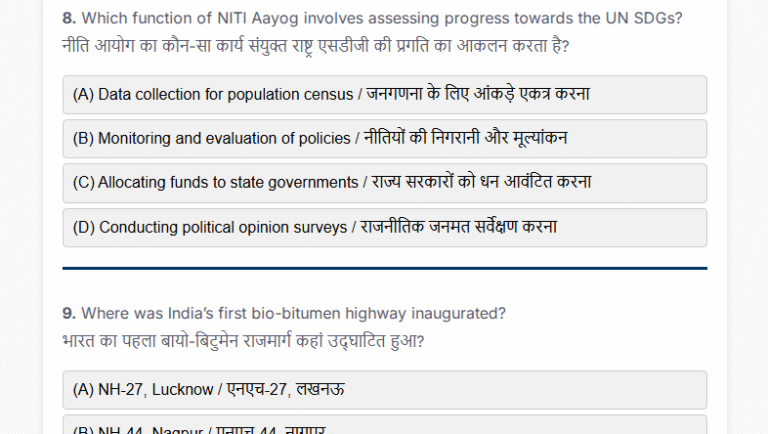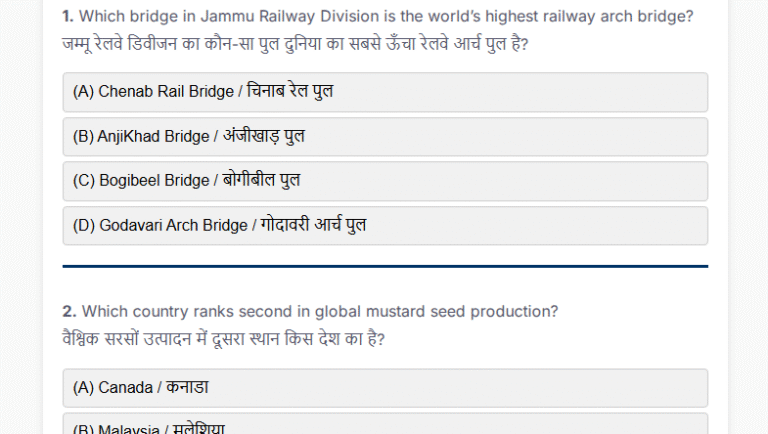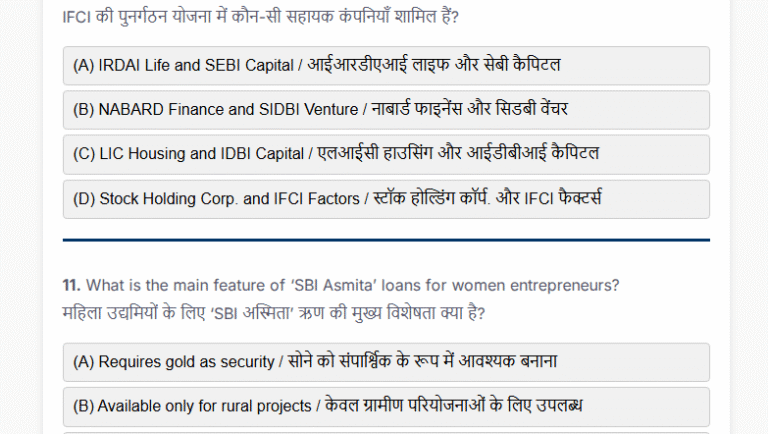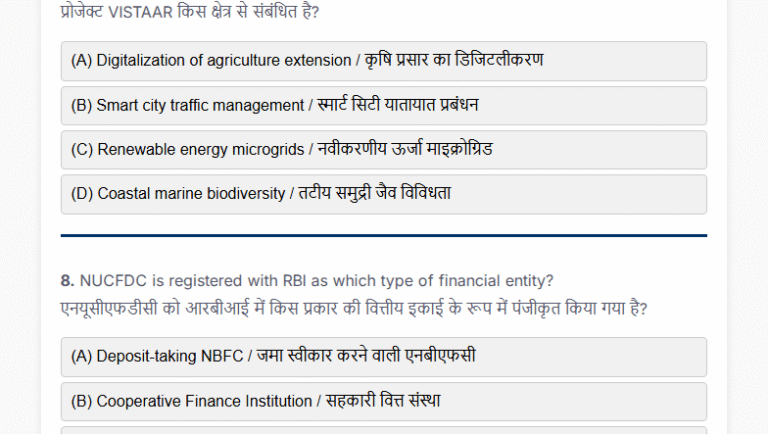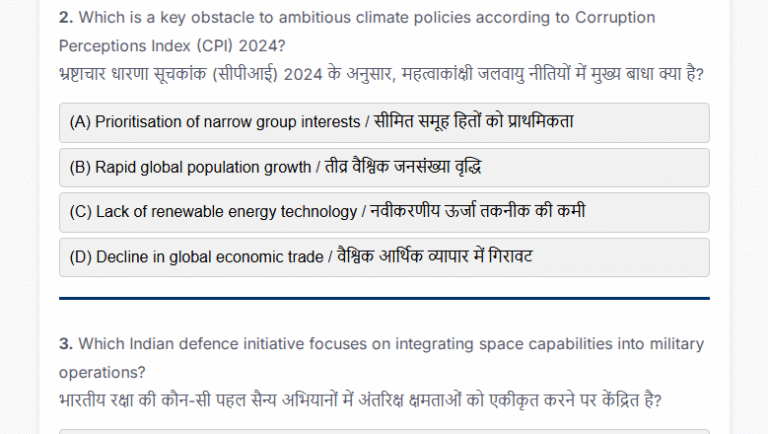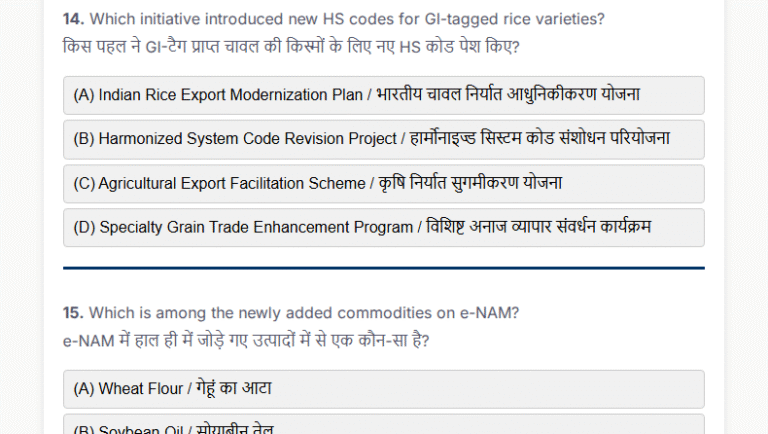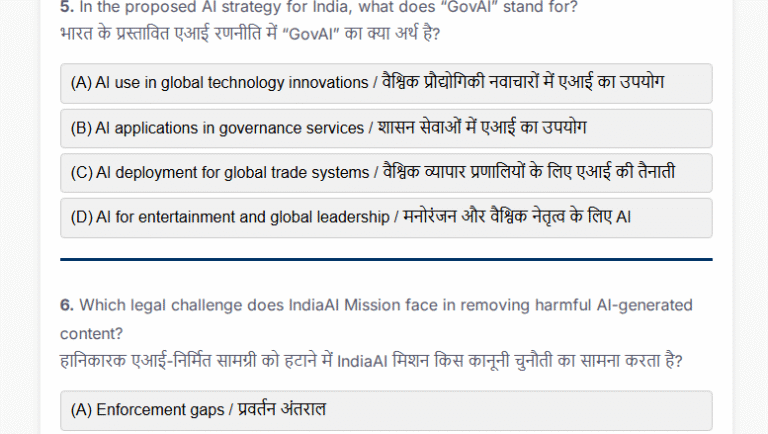Current Affairs Today MCQs (18 Nov 2024)
1. Which of the following countries joined BRICS as new members in 2024?
(A) Turkey and Nigeria
(B) Iran and UAE
(C) Algeria and Ethiopia
(D) Thailand and Vietnam
The correct answer is (B) Iran and UAE
In 2024, BRICS expanded its membership to include Iran, Ethiopia, Egypt, and the UAE. This expansion reflects the bloc’s aim to strengthen its global influence and enhance economic cooperation.
2. What is the primary objective of offering the “Partner Country Status” in BRICS?
(A) To guide the bloc’s future expansion
(B) To establish bilateral trade agreements
(C) To increase foreign direct investment
(D) To provide financial aid
The correct answer is (A) To guide the bloc’s future expansion
The “Partner Country Status” introduced during the 16th BRICS Summit serves as a transitional mechanism to guide the organization’s expansion, enabling closer collaboration with non-member states.
3. What was the central aim of the Mundaism movement led by Birsa Munda?
(A) To adopt Western education
(B) To embrace British laws
(C) To revive traditional Munda customs and resist oppression
(D) To align tribal practices with mainstream religion
The correct answer is (C) To revive traditional Munda customs and resist oppression
The Mundaism movement sought to revive Munda traditions, promote self-reliance, and resist the British and missionary influence. It united tribals in their fight against exploitation and loss of land.
4. What percentage of global GDP is represented by BRICS after its 2024 expansion?
(A) 20%
(B) 28%
(C) 25%
(D) 30%
The correct answer is (B) 28%
With its expanded membership, BRICS economies now collectively contribute 28% of global GDP. This highlights the bloc’s economic significance on the world stage.
5. How many districts are being targeted in the first phase of PM-JANMAN?
(A) 50
(B) 100
(C) 150
(D) 200
The correct answer is (B) 100
The initial phase of PM-JANMAN aims to cover 100 districts, focusing on providing essential services and entitlements to PVTG families across 15,000 habitations.
6. When was the BRICS grouping formally established?
(A) 2006
(B) 2007
(C) 2009
(D) 2010
The correct answer is (A) 2006
The formal establishment of BRICS occurred during the BRIC Foreign Ministers’ meeting in 2006. South Africa joined in 2010, making it BRICS.
7. What was the key objective of the Ulgulan or Great Tumult movement?
(A) To promote modern agriculture
(B) To support British governance
(C) To spread Christianity
(D) To oppose forced labor and land alienation
The correct answer is (D) To oppose forced labor and land alienation
The Ulgulan movement mobilized Munda and Oraon tribals against forced labor, missionary activities, and land dispossession under British colonial rule. It laid the foundation for tribal land rights.
8. Which of the following is a key feature of PM-JANMAN?
(A) Promotion of tribal crafts
(B) Expansion of tribal tourism
(C) Providing basic entitlements to PVTGs
(D) Establishing tribal research centers
The correct answer is (C) Providing basic entitlements to PVTGs
PM-JANMAN focuses on providing PVTG families with essential services like housing, water, electricity, education, and healthcare, ensuring their socio-economic development.
9. What does the Mundari Khuntkattidar system recognize?
(A) Original settlers of the land among the Mundas
(B) Non-tribal ownership of land
(C) British rights to tribal lands
(D) Missionary control over tribal regions
The correct answer is (A) Original settlers of the land among the Mundas
The Mundari Khuntkattidar tenure system established under the Chotanagpur Tenancy Act recognizes the original Munda settlers’ rights to their ancestral lands, protecting them from exploitation.
10. Which is a defining characteristic of Particularly Vulnerable Tribal Groups (PVTGs)?
(A) Urban migration
(B) High literacy rates
(C) Dependence on Non-Timber Forest Produce (NTFP)
(D) Advanced agricultural technology
The correct answer is (C) Dependence on Non-Timber Forest Produce (NTFP)
PVTGs rely heavily on NTFP for their livelihood, reflecting their traditional lifestyle and connection with nature. Other characteristics include low literacy, economic backwardness, and reliance on primitive technology.
11. In which year was the Suez Canal officially opened for ships?
(A) 1859
(B) 1869
(C) 1879
(D) 1889
The correct answer is (B) 1869
The Suez Canal, a vital maritime route connecting the Mediterranean Sea to the Red Sea, was officially opened in 1869. Its creation significantly reduced the maritime distance between Europe and Asia, revolutionizing global trade and commerce.
12. Approximately what percentage of global trade passes through the Suez Canal?
(A) 5%
(B) 10%
(C) 12%
(D) 15%
The correct answer is (C) 12%
The Suez Canal facilitates around 12% of global trade. It serves as a crucial waterway for international shipping, connecting major economies and playing a vital role in the global supply chain.
13. What was the estimated loss to international trade during the first week of the 2021 Suez Canal blockage?
(A) $50 million
(B) $90 million
(C) $100 million
(D) $120 million
The correct answer is (B) $90 million
The 2021 Suez Canal blockage caused significant disruption to global trade, with an estimated $90 million loss in just the first week. The incident underscored the canal’s importance in the global supply chain.
14. What makes the Suez Canal unique compared to other major canals?
(A) It does not have locks and is a sea-level waterway
(B) It is the longest canal in the world
(C) It connects two oceans directly
(D) It is used only for military purposes
The correct answer is (A) It does not have locks and is a sea-level waterway
The Suez Canal is a sea-level waterway without locks, which allows for smoother and more efficient passage of vessels. This feature supports the high volume of maritime traffic passing through the canal.
15. Which country relies heavily on revenue generated by the Suez Canal?
(A) Saudi Arabia
(B) Egypt
(C) Turkey
(D) Greece
The correct answer is (B) Egypt
The Suez Canal is a major source of revenue for Egypt, contributing significantly to its economy through tolls collected from passing ships.
16. What promise was made to the Māori in the 1840 Treaty of Waitangi?
(A) Free education and healthcare
(B) Representation in the British Parliament
(C) Rights to their lands and interests
(D) Autonomy to form their government
The correct answer is (C) Rights to their lands and interests
The Treaty of Waitangi, signed in 1840, promised the Māori rights to their lands and interests while ceding governance to the British Crown. It remains New Zealand’s foundational document.
17. What does the haka dance primarily symbolize?
(A) Cultural pride, strength, and unity
(B) Mourning and grief
(C) Spiritual connection
(D) Celebration and relaxation
The correct answer is (A) Cultural pride, strength, and unity
The haka is a ceremonial dance performed by the Māori that symbolizes cultural pride, strength, and unity. It is performed during battles, greetings, funerals, and significant events.
18.By how many kilometers does the Suez Canal shorten the maritime distance between Europe and Asia?
(A) 5,000 km
(B) 7,000 km
(C) 9,000 km
(D) 10,000 km
The correct answer is (B) 7,000 km
The Suez Canal significantly reduces maritime travel distance between Europe and Asia by approximately 7,000 kilometers, making it a critical route for global trade and commerce.
19. What percentage of the world’s oil passes through the Suez Canal?
(A) 7%
(B) 8%
(C) 10%
(D) 12%
The correct answer is (A) 7%
The Suez Canal facilitates the transportation of about 7% of the world’s oil, making it essential for energy trade and global economic stability.
20. What physical feature of the Suez Canal enables smoother passage for vessels?
(A) The absence of sharp bends
(B) Its direct connection to two major seas
(C) Its status as a sea-level canal without locks
(D) Its minimal water depth
The correct answer is (C) Its status as a sea-level canal without locks
The Suez Canal’s design as a sea-level waterway without locks allows vessels to transit smoothly and efficiently, supporting its status as one of the busiest waterways globally.
_
Set 20 Quarterly CA 2025 Jan to March IMPORTANT INSTRUCTIONS This test consists of 25 questions.At…
Set 19 Quarterly CA 2025 Jan to March IMPORTANT INSTRUCTIONS This test consists of 25 questions.At…
Set 18 Quarterly CA 2025 Jan to March IMPORTANT INSTRUCTIONS This test consists of 25 questions.At…
Set 17 Quarterly CA 2025 Jan to March IMPORTANT INSTRUCTIONS This test consists of 25 questions.At…
Set 16 Quarterly CA 2025 Jan to March IMPORTANT INSTRUCTIONS This test consists of 25 questions.At…
Set 15 Quarterly CA 2025 Jan to March IMPORTANT INSTRUCTIONS This test consists of 25 questions.At…
Set 14 Quarterly CA 2025 Jan to March IMPORTANT INSTRUCTIONS This test consists of 25 questions.At…
Set 13 Quarterly CA 2025 Jan to March IMPORTANT INSTRUCTIONS This test consists of 25 questions.At…
Set 12 Quarterly CA 2025 Jan to March IMPORTANT INSTRUCTIONS This test consists of 25 questions.At…
Set 11 Quarterly CA 2025 Jan to March IMPORTANT INSTRUCTIONS This test consists of 25 questions.At…
Set 10 Quarterly CA 2025 Jan to March IMPORTANT INSTRUCTIONS This test consists of 25 questions.At…
Set 9 Quarterly CA 2025 Jan to March IMPORTANT INSTRUCTIONS This test consists of 25 questions.At…
Set 8 Quarterly CA 2025 Jan to March IMPORTANT INSTRUCTIONS This test consists of 25 questions.At…
Set 7 Quarterly CA 2025 Jan to March IMPORTANT INSTRUCTIONS This test consists of 25 questions.At…
Set 6 Quarterly CA 2025 Jan to March IMPORTANT INSTRUCTIONS This test consists of 25 questions.At…
Set 5 Quarterly CA 2025 Jan to March IMPORTANT INSTRUCTIONS This test consists of 25 questions.At…
Set 4 Quarterly CA 2025 Jan to March IMPORTANT INSTRUCTIONS This test consists of 25 questions.At…
Set 2 Quarterly CA 2025 Jan to March IMPORTANT INSTRUCTIONS This test consists of 25 questions.At…
Set 3 Quarterly CA 2025 Jan to March IMPORTANT INSTRUCTIONS This test consists of 25 questions.At…
Test Series of 1st Quarterly Current Affairs 2025 प्रथम त्रैमासिक करेंट अफेयर्स 2025 की टेस्ट सीरीज़…
Current Affairs Today MCQs (26 Nov 2024) 1. What is the primary purpose of the Rejang Dewa dance in…
Current Affairs Today MCQs (25 Nov 2024) 1. What feature distinguishes African penguins from other…
Current Affairs Today MCQs (24 Nov 2024) 1. Which of the following is a distinctive feature of…
Current Affairs Today MCQs (23 Nov 2024) 1. What is the target adaptation finance commitment for the…
Current Affairs Today MCQs (22 Nov 2024) 1. How many youth are targeted for internships under the PM…
Current Affairs Today MCQs (21 Nov 2024) 1. Which is the funding ratio for PM-JAY between the Centre…
Current Affairs Today MCQs (20 Nov 2024) 1. Who is eligible for the Ayushman Vay Vandana Card? (A)…
Current Affairs Today MCQs (5 Nov 2024) 1. What conditions contribute to the formation of the DANA…
Current Affairs Today MCQs (4 Nov 2024) 1. What is the primary function of Israel’s Iron Beam…
Current Affairs Today MCQs (3 Nov 2024) 1. To whom was the Balfour Declaration addressed? (A) David…
